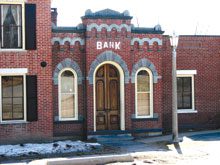 Portfolio vs. conventional lenders
Portfolio vs. conventional lenders
A Portfolio Bank is a bank that lends their own funds into mortgages. They keep the mortgages in the bank and service the loans, which is a real advantage to homeowners. Portfolio lenders tend to be local banks and credit unions.
A portfolio lender is able to make their own rules and guidelines; this can offer their customers more flexibility and creativity than other, non-portfolio lenders can offer. Portfolio lenders’ rules are generally more flexible (but not necessarily easier for someone with an uncertain borrowing history).
Lenders who don’t have capital to lend stay in business by selling their debt into the secondary mortgage market. What’s that? It is a government-sponsored enterprise that buys mortgages from mortgage lenders, packages them together, and sells them as a mortgage-backed security to investors on the open market. Most residential mortgages are sold to Fannie Mae (FNMA). Selling the mortgages gives money back to the lenders, so they can lend it out again, and collect fees for doing so.
Lenders who are selling their mortgages back to the secondary market require that borrowers conform to a set of guidelines. Thus, they deal in conforming mortgages: the ones that fit into national standards for lending. Non-portfolio lenders are sometimes called conforming lenders, for that reason.
What portfolio lenders can do that conforming lenders can’t: Recasting a mortgage
 I’ve been doing exclusive buyer’s agency a long time. But I still run into things that I hadn’t heard of before. It happened again, recently. I met with Ellen Klapper, from Eastern Bank, which is a portfolio lender. She mentioned recasting of a mortgage. I said, “What’s that?”
I’ve been doing exclusive buyer’s agency a long time. But I still run into things that I hadn’t heard of before. It happened again, recently. I met with Ellen Klapper, from Eastern Bank, which is a portfolio lender. She mentioned recasting of a mortgage. I said, “What’s that?”
Recasting is the ability to change the monthly payment on a mortgage when you pay down your balance.
Here’s how it works.
If you borrow, let’s say, $500,000 at 3.75%, your principal and interest will be $2,315 for a 30-year mortgage. Suppose you come into a legacy, or sell another home or asset or get a bonus. Now you have an extra $100,000 to pay down your mortgage.
(I am using $100,000 as an example, but recasting programs allow smaller paydowns; some start at $5,000.)
Recasting
If you have your mortgage with a portfolio lender, you may have the option to recast your mortgage. Recasting allows you to change your existing mortgage without refinancing.
At the three-year point in your thirty-year mortgage, you have a principal balance of $470,510. If you pay down by $100,000, you’d owe $370,510. With recasting, you’d now have a 27-year mortgage for $370,510. Principal and interest on that is $1,820 for the next 27 years. That saves you $160,380 over the life of the mortgage. For many, the big benefit is that it makes your monthly bills roughly $500 a less every month.
If you pay down by $100,000 at the ten-year point, you have a principal balance of $389,500. You’d owe $289,500 after the paydown. Principal and interest on that is $1,716 for the next 20 years. That saves you $143,760 over the life of the mortgage.
Pay down of a conforming mortgage
If you have a conforming mortgage, your payment cannot be changed.
If you paydown by $100,000 at the three-year point, that additional $100,000 shortens the length of time that you pay your mortgage by 100 months. Your monthly bills stay the same, but your mortgage is paid off much faster, saving you $231,500 over the 30-year period.
If you come into money later in the life of your mortgage, the benefit is not nearly as good. Suppose you pay down by $100,000 at the ten-year point. Then, you are shortening the mortgage by 61 months. That’s a savings of $141,215, with no change in your monthly payments.
Summary:
If lowering your monthly mortgage payments would be a big benefit to your lifestyle, and you expect to come into a legacy or get a large bonus, consider seeking out a portfolio lender when you purchase your house.


Leave A Comment